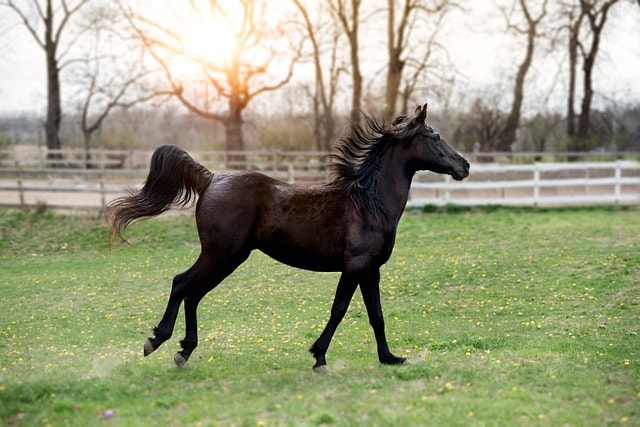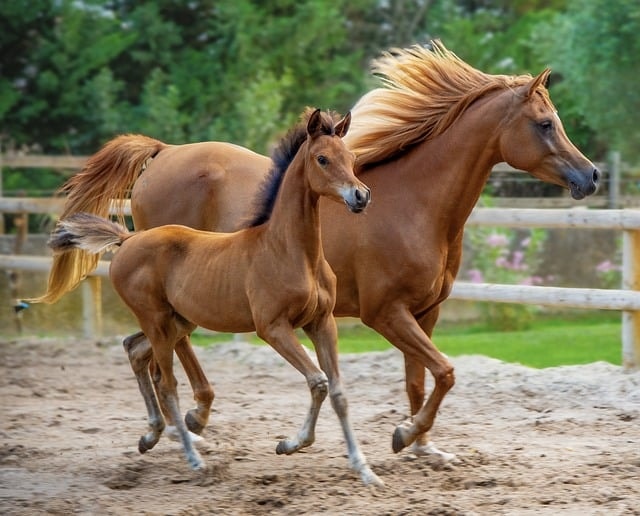Joint inflammation in horses: causes, symptoms and treatment

Joint inflammation, also known as arthritis, is one of the most common and serious diseases that can affect horses. Not only does it affect the animal's quality of life, but it can also lead to chronic pain and limited mobility in the long term. In this article, you will learn everything you need to know about the causes, symptoms, diagnosis, treatment and prevention of joint inflammation in horses.
What is joint inflammation in horses?
Arthritis is an inflammation of one or more joints that can be caused by various reasons. It leads to damage to the joint structure and reduced mobility. This joint disease can be acute, meaning that it is sudden and severe, or chronic, which indicates long-lasting and slowly developing inflammation.
Causes of joint inflammation/arthritis in horses
The causes of joint inflammation in horses are varied and can be caused by both external influences and internal diseases. Here are the most common causes in detail:
-
Overloading and incorrect loading of your horse : Intensive training loads, one-sided movement patterns or incorrect shoeing can lead to an overload of certain joints, which in the long term results in inflammation.
-
Injuries and trauma : A blow to the joint, a fall or a twist can damage the joint structures and cause inflammation. Such injuries are particularly common in horses that are involved in sport.
-
Infections : Bacteria can enter the joint through open wounds or surgical scars and cause septic arthritis in the horse. This form of joint inflammation is particularly dangerous and must be treated immediately.
-
Degenerative joint diseases : As we age, degenerative changes such as the breakdown of joint cartilage can develop, resulting in chronic inflammation.
-
Autoimmune diseases : In rare cases, the horse's immune system can attack its own joints, causing inflammation.
Symptoms of joint inflammation/arthritis
Joint inflammation in horses manifests itself through various symptoms, which can vary depending on the severity and duration of the disease:
-
Lameness : A common sign in a horse with arthritis is lameness, especially after periods of rest or intense exercise. This is usually the first symptom you will notice.
-
Swelling and overheating : The affected joint may be swollen and warm to the touch. This indicates acute inflammation.
-
Pain sensitivity : Horses are often sensitive to pressure or movement of the inflamed joint. You may notice your horse becoming restless or protecting the joint.
-
Stiffness : The horse may appear stiff and immobile, especially in the morning or after a long period of rest. This is typical of chronic inflammation.
-
Altered gait : Your horse may exhibit an altered gait as it tries to relieve the affected joint. This may manifest itself in shortened strides or a limp.
Diagnostic procedures: How is joint inflammation diagnosed in horses?
Diagnosing joint inflammation/arthritis requires a thorough examination of your horse by a veterinarian. This usually involves several steps:
-
Clinical examination : The veterinarian will examine the horse for lameness and tenderness by palpating the affected joint and checking for swelling, warmth and other signs of inflammation.
-
Imaging procedures : X-rays, ultrasound examinations or MRIs are often used to assess the condition of the joint more precisely. These methods help to detect structural changes in the joint.
-
Synovial fluid analysis : In some cases, a sample of synovial fluid is taken and examined in the laboratory. This can reveal the presence of inflammatory cells or bacteria and rule out septic arthritis.
-
Blood tests : If a systemic disease or an autoimmune disease is suspected, blood tests can help detect inflammatory markers or autoantibodies.
Treatment options for inflamed joints in horses
The treatment of arthritis in horses depends on the cause and severity of the disease. Here are the most common treatment approaches:
-
Anti-inflammatory drugs : Non-steroidal anti-inflammatory drugs (NSAIDs) are the first choice for relieving pain and inflammation. In severe cases, corticosteroids may also be used.
-
Antibiotics : If there is a bacterial infection, antibiotics are essential to kill the bacteria and control the inflammation.
-
Immobilization and rest : Temporary immobilization of the affected joint may be necessary to allow inflammation to subside. This can be achieved by box rest or by restricting movement.
-
Physiotherapy and rehabilitation : After the acute phase of inflammation, targeted physiotherapy is important to restore mobility and strengthen the muscles around the joint. Hydrotherapy, massages and passive stretching can be helpful here.
-
Joint injections : Injections of hyaluronic acid or PRP (platelet-rich plasma) directly into the joint can improve joint function and reduce inflammation.
-
Surgical interventions : In advanced cases where conservative treatments are not sufficient, surgery may be necessary to remove damaged structures or stabilize the joint.
Prevention: How to prevent joint inflammation in your horse
Preventing arthritis is crucial to maintaining your horse's well-being and performance. Here are some steps you can take:
-
Adapted training : Well-structured training tailored to the individual horse is important to avoid overloading. Make sure there are sufficient warm-up phases and vary the loads.
-
Optimal hoof care : Regular hoof care and correct shoeing are essential to prevent incorrect loading of the joints.
-
Nutrition and feed additives : A balanced diet with special feed additives such as omega-3 fatty acids, glucosamine and chondroitin can support joint health. These substances help to maintain the joint cartilage and prevent inflammation. Here you will find a range of suitable products for building muscle in your horse and strengthening the tendons, ligaments and joints.
-
Weight control : Being overweight puts additional strain on the joints and can increase the risk of arthritis. Make sure your horse maintains its ideal weight.
-
Regular exercise : Horses should be exercised regularly to keep the joints moving and promote blood circulation. Long periods of standing in the stable should be avoided.
-
Regular veterinary examinations : Through regular examinations, the veterinarian can detect signs of joint inflammation early and act accordingly.
The Influence of Age on Arthritis in Horses
As horses get older, the risk of degenerative joint disease and joint inflammation increases. Older horses tend to become stiffer and show more signs of lameness. Particularly careful care and training adjustments are required to protect the joints and prevent inflammation.
Nutrition and joint health: The importance of a balanced diet for your horse
Nutrition plays a central role in your horse's overall health, especially joint health. A balanced and nutrient-rich diet can not only improve your horse's vitality and well-being, but can also help prevent joint inflammation and alleviate existing joint problems.
Nutrients for healthy joints in horses
In order to optimally support your horse's joints, certain nutrients should not be missing from the daily diet:
-
Antioxidants : Antioxidants such as vitamins C and E play an important role in fighting free radicals that can damage joint tissue. Through their anti-inflammatory effects, they help slow the wear and tear of joint cartilage and reduce inflammation.
-
Omega-3 fatty acids : Omega-3 fatty acids are essential for joint health. They have a strong anti-inflammatory effect and can help to relieve the symptoms of joint inflammation. Particularly valuable sources of omega-3 fatty acids are fish oil and linseed, which can be used in horse feed to reduce the risk of inflammation and support the joints.
-
Glucosamine and chondroitin : These natural components of articular cartilage support the regeneration of cartilage tissue and help prevent its degradation. Supplementary feed containing glucosamine and chondroitin are particularly recommended for older horses or those with existing arthritis.
-
Minerals : A sufficient supply of minerals such as zinc, copper and manganese is essential for the synthesis of collagen, which is an important component of the cartilage of the joints. These minerals promote the stability and elasticity of the joints and prevent degenerative changes.
The Role of Feeding in Arthritis Prevention
A balanced diet rich in anti-inflammatory and cartilage-supporting nutrients can make a significant contribution to the prevention of arthritis. A special focus should be on avoiding excess weight, as excess body weight puts a lot of strain on the joints and increases the risk of inflammation.
By feeding specific supplementary feeds that contain special nutrients to support the joints, you can actively contribute to the prevention of joint inflammation. Such supplements are particularly recommended during times of increased stress, such as during intensive training phases or for older horses.
Practical tips for feeding
-
Incorporate Omega-3 Rich Feeds : Add Omega-3 rich feeds such as flaxseed or fish oil to your horse's daily ration to benefit from their anti-inflammatory properties.
-
Choose high-quality supplements : Pay attention to the quality and composition of supplements specifically designed for joint health. Products containing glucosamine, chondroitin and MSM (methylsulfonylmethane) are particularly effective.
-
Avoid overfeeding : Keep an eye on your horse's body weight and adjust the amount of food accordingly to prevent excess weight, which puts additional strain on the joints.
A well-thought-out and balanced diet is a fundamental part of the holistic care and health promotion of your horse. By using feed and supplements specifically tailored to joint health, you can actively contribute to your horse's longevity and mobility.
Importance of rehabilitation after joint inflammation in horses
Rehabilitation after joint inflammation is a crucial step on the road to full recovery. An individually tailored rehabilitation plan that includes physiotherapy, controlled exercise and, if necessary, hydrotherapy will help your horse regain full mobility and performance. Careful monitoring and adjustment of the plan by the veterinarian or physiotherapist is important to avoid relapses.

The holistic approach to joint health in horses
Joint inflammation/arthritis in horses is a complex and multifaceted disease that can be triggered by various factors. Early diagnosis and targeted treatment are crucial to maintaining your horse's quality of life and preventing long-term damage. Both medical interventions and preventive measures play an important role.
A holistic approach that includes a balanced diet, appropriate exercise, regular veterinary examinations and careful care of the musculoskeletal system is key to preventing arthritis in horses. In addition, individual adaptation of training and hoof care is essential to avoid overload and promote joint health.
Even after successful treatment, ongoing monitoring and care of the joints remains important to prevent relapse. With proper care and attention, you can help your horse live a healthy and active life despite the challenges that joint inflammation can bring.












